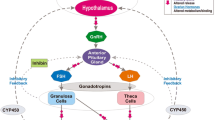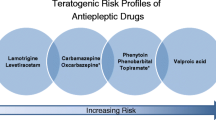Abstract
Population–based studies documented a decrease of congenital malformations (especially neural tube defects, NTD) in children of women who received a folic acid supplementation prior to pregnancy and during the first 2–3 months after conception. A daily dosage of folic acid of 0.4–0.8 mg was effective. In women who already had borne a child with a NTD a folic acid supplementation of 4 mg/day reduced the NTD–risk for further children significantly. However, current data do not indicate that the additional risk of congential malformations induced by antiepileptic drugs is reduced by the supplementation of folic acid.
Zusammenfassung
Populationsstudien in Ungarn und China haben gezeigt, dass die präkonzeptionell beginnende Folsäureergänzung in einer Tagesdosis von 0,4–0,8 mg das Risiko kindlicher großer Fehlbildungen (insbesondere von Neuralrohrdefekten, NTD) signifikant mindert. Die Folsäuregabe gleicht die ernährungsbedingt zu geringe Folsäure–Körperkonzentration aus. Bei Frauen, die bereits ein Kind mit einem NTD zur Welt gebracht hatten, minderte die präkonzeptionell beginnende Gabe von 4 mg Folsäure/ Tag das Fehlbildungsrisiko für weitere Kinder signifikant. Derzeit gibt es allerdings keine Hinweise darauf, dass die Folsäuregabe das zusätzlich durch Antiepileptika vermittelte Fehlbildungsrisiko reduziert.
Similar content being viewed by others
References
ACOG Educational Bulletin (1997) Seizure disorders in pregnancy. Int J Gynecol Obstet 56:279–286
Anderson RC (1976) Cardiac defects in children of mothers receiving anticonvulsant therapy during pregnancy. J Pediatr 89:318–319
Anonymous (1982) Valproic acid and spina bifida: a preliminary report- France. MMWR Morb Mortal Wkly Rep 31:565–566
Barrett C, Richens A (2003) Epilepsy and pregnancy: report of an epilepsy research foundation workshop. Epilepsy Res 52:147–187
Berg K, Lindhout D (2002) Antiepileptic drugs in pregnancy: options for prevention of congenital abnormalities. Commun Genet 5:40–49
Berry RJ, Li Z, Erickson JD, Li S, Moore CA, Wang H, Mulinare J, Zhao P, Wong LYC, Gindler J, Hong SX, Correa A (1999) Prevention of neural-tube defects with folic acid in China. N Engl J Med 341:1485–1490
Bertollini R, Mastroiacovo P, Segni G (1985) Maternal epilepsy and birth defects: a case control study in the Italian multi-centric registry of birth defects (IPIMC). Eur J Epidemiol 1:67–72
Bjerkedal T, Czeizel A, Goujard J, Kallen B, Mastroiacova P, Nevin N, Oakley G Jr, Robert E (1982) Valproic acid and spina bifida. Lancet 2:1096
Botto LD, Moore CA, Khoury MJ, Erickson JD (1999) Neural-tube defects. N Engl J Med 341:1509–1519
Bower C, Stanley FJ, Nicol DJ (1993) Maternal folate status and the risk for neural tube defects – the role of dietary folate. Ann NY Acad Sci 678:146–155
Brown JE, Jacobs DR, Hartman TJ (1997) Predictors of red cell folate level in women attempting pregnancy. JAMA 277:548–552
Bundesinstitut für gesundheitlichen Verbraucherschutz und Veterinärmedizin (BgVV) (2001) Neues Informationsblatt: Zum Kinderwunsch gehört Folsäure! BgVV Pressedienst 08
Campbell LR, Sohal GS (1990) The pattern of neural tube defects created by secondary reopening of the neural tube. J Child Neurol 5:336–340
Carter PL, Montague JC, Buffalo MD (1980) Preliminary data relative to the correlation of medications taken during the first trimester of pregnancy and subsequent cleft palate. Folia Phoniat 32:298–308
CDC (1992) Recommendations for the use of folic acid to reduce the number of cases of spina bifida and other neural tube defects. MMWR 41:1–14
COMA report 41 (1991) Dietary reference values for food, energy and nutrients for the United Kingdom. HM Stationery Office, London
Connor JM, Ferguson-Smith MA (1984) Essential medical genetics. Blackwell, Scientific Publ, Oxford
Czeizel AE, Dudás I (1992) Prevention of the first occurrence of neuraltube defects by periconceptional vitamin supplementation. N Engl J Med 327:1832–1835
Czeizel AE (1996) Reduction of urinary tract and cardiovascular defects by periconceptional multivitamin supplementation. Am J Med Genet 62:179–183
Daly LE, Kirke PN, Molloy A, Weir DG, Scott JM (1995) Folate levels and neural tube defects. Implications for prevention. JAMA 274:1698–1702
Dansky LV, Finnell LV (1991) Parental epilepsy, anticonvulsant drugs, and reproductive outcome: epidemiological and experimental findings spanning three decades; 2: human studies. Reprod Toxicol 5:301–335
Delgado-Escueta AV, Janz D (1992) Pregnancy and teratogenesis in epilepsy. Neurology 42(Suppl 5):7
Deutsche Gesellschaft für Ernährung (DGE) (2000) Referenzwerte für die Nährstoffzufuhr, 1. Auflage. Umschau, Frankfurt
Elmazar MM, Nau H (1992) Methotrexate increases valproic acid-induced developmental toxicity, in particular neural tube defects in mice. Teratog Carcinog Mutagen 12:203–210
Elmazar MM, Nau H (1993) Trimethoprim potentiates valproic acidinduced neural tube defects (NTDs) in mice. Reprod Toxicol 7:249–254
Erickson JD, Oakley GP (1974) Seizure disorders in mothers of children with orofacial clefts. A case-control study. J Pediatr 84:244–246
Food and Agricultural Organisation of the United Nations (FAO) (1988) Requirements of vitamin A, iron folate and vitamin B12. FAO, Rom
Fröscher W (1988) Folsäure und Epilepsie. Epilepsieblätter 1:72–76
Girdwood RH, Lenham JAR (1956) Megaloblastic anemia during primidone therapy. Br Med J 1:146–147
Göltner E (1971) Folsäuremangel und Schwangerschaft. Med Klin 66:973–976
Hendel J, Dam M, Gram L, Winkel P, Jorgensen J (1984) The effect of carbamazepine and valproate on folate metabolisms in man. Acta Neurol Scand 69:226–231
Hernández-Díaz S, Werler MM, Walker AM, Mitchell AA (2000) Folic acid antagonists during pregnancy and the risk of birth defects. N Engl J Med 343:1608–1614
Hernández-Díaz S, Werler MM, Walker AM, Mitchell AA (2001) Neural tube defects in relation to use of folic acid antagonists during pregnancy. Am J Epidemiol 153:961–968
Ibbotson RN, Dilena BA, Horwood JM (1967) Studies of deficiency and absorption of folates in patients on anticonvulsants. Aust Ann Med 16:144–150
Jensen ON, Olesen OV (1969) Folic acid and anticonvulsive drugs. Arch Neurol 21:208–214
Källén B, Robert E, Mastroiacovo P, Martinez-Frias ML, Castilla EE, Cocchi G (1989) Anticonvulsant drugs and malformations: is there a drug specifity? Eur J Epidemiol 5:31–36
Kelly TE (1984) Teratogenicity of anticonvulsant drugs 1: review of the literature. Am J Med Genet 19:413– 434
Kishi T, Fujita N, Eguchi T, Ueda K (1997) Mechanism for reduction of serum folate by antiepileptic drugs during prolonged therapy. J Neurol Sci 145:109–112
Konishi H, Morita K, Ono T, Shimakawa H (1990) Effects of zonisamide on cytochrome P-450-dependent monooxygenases in mouse hepatic microsomes. Yakuzaigaku 50:323–328
Lakos P, Czeizel E (1977) A teratological evaluation of anticonvulsant drugs. Acta Paediatr Acad Sci Hung 18:145–153
Lindhout D, Meinardi H (1984) Spina bifida and in-utero exposure to valproate. Lancet 2:396
Maxwell JD, Hunter J Stewart DA, Ardeman S, Williams R (1972) Folate deficiency after anticonvulsant drugs: an effect of hepatic enzyme induction? Br Med J 1:297–299
Meadow SR (1968) Anticonvulsant drugs and congenital abnormalities. Lancet 2:1296
Moore KL (1990) Angeborene Fehlbildungen des Menschen. In: Moore KL (Hrsg) Grundlagen der medizinischen Embryologie. Enke, Stuttgart, S 54–62
MRC Vitamin Study Research Group (1991) Prevention of neural tube defects: results of the Medical Research Council Vitamin Study. Lancet 338:131–137
National Research Council (1989) Recommended dietary allowances. National Academy Press, Washington
Nelson MM, Wolstenholme GEW, O’Connor CM (1960) Ciba Foundation symposium on congenital malformations. Churchill, London
Perucca E, Hedges A, Makki KA, Ruprah M, Wilson JF, Richens A (1984) A comparative study of the relative enzyme inducing properties of anticonvulsant drugs in epileptic patients. Br J Clin Pharmacol 18:401–410
Perucca E (1987) Clinical implications of hepatic microsomal enzyme induction by antiepileptic drugs. Pharmacol Ther 33:139–144
Reynolds EH (1973) Anticonvulsants, folic acid, and epilepsy. Lancet 1:1376–1378
Rinke U, Koletzko B (1991) Prävention von Neuralrohrdefekten durch Folsäurezufuhr in der Frühschwangerschaft. Dt Ärztebl 1/2:A-30–37
Robert E, Guibaud P (1982) Maternal valproic acid and congenital neural tube defects. Lancet 2:937
Robert E, Rosa FW (1983) Valproate and birth defects. Lancet 2:1142
Samrén EB, Lindhout D (1997) Major malformations associated with maternal use of antiepileptic drugs. In: Tomson T, Gram L, Sillanpää M, Johannessen SI (Hrsg) Epilepsy and Pregnancy. Wrightson Biomedical Publ, Petersfield and Bristol, pp 43–61
Schneider A, Sterzik K (1995) Präkonzeptionelle Folsäuregabe zur Prävention von Neuralrohrdefekten. Dt Ärztebl 92:A-1771–1771
Wegner C, Nau H (1992) Alteration of embryonic folate metabolism by valproic acid during organogenesis: Implications for mechanism of teratogenesis. Neurology 42(Suppl 5):17–24
Werler MM, Shapiro S, Mitchell AA (1993) Periconceptional folic acid exposure and risk of occurrent neural tube defects. JAMA 269:1257–1261
Author information
Authors and Affiliations
Corresponding author
Rights and permissions
About this article
Cite this article
Schmitt, E., Bauer, J. Mindert eine Folsäuresubstitution die Teratogenität von Antiepileptika?. Z Epileptol 17, 199–208 (2004). https://doi.org/10.1007/s10309-004-0069-1
Received:
Accepted:
Published:
Issue Date:
DOI: https://doi.org/10.1007/s10309-004-0069-1




